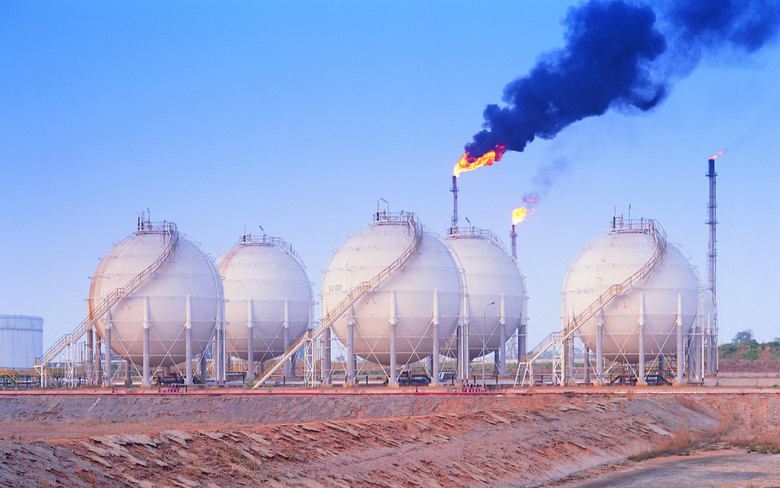How Does Land Pollution Affect The Environment?
Industrial and agricultural activities often release contaminants into the environment that can disrupt the various species living in an ecosystem. From toxicity to radioactivity, contaminants can have a wide range of negative effects on living organisms. These effects depend on the nature of the contaminants and how long they persist in the environment. Different types of land pollution may severely affect both animal and plant life in an ecosystem, and may impair the functioning of the ecosystem as a whole. Processes such as phytoremediation are being used to help combat the negative effects of land pollution on the environment.
Sources and Types of Contamination
Sources and Types of Contamination
From landfill seepage to chemical spills to illegal dumping, land pollution can come from a variety of sources. Unfortunately, small-scale pollution enters the ground on a regular basis, often without anyone's knowledge. Evidence of steady, localized pollution is often detected years after it has been occurring.
Oil spills are some of the more noteworthy land pollution events because they are frequently detected as they are happening. In September 2013, a farmer discovered oil seeping up from below his wheat field near Tioga, North Dakota. The oil spill, which leaked about 20,000 barrels in total, was eventually traced to a pipeline owned by the Tesoro Corporation. Oil or petroleum spills are hazardous because they are toxic, flammable and potentially explosive. Other types of pollution-related hazards considered by the EPA include chemical reactivity and radioactivity.
Metal Contaminants and Effects
Metal Contaminants and Effects
Soil pollution occurs when hazardous substances are mixed with naturally occurring soil. These artificial contaminants are either attached to soil particles or are trapped within the soil, and can have devastating effects on an ecosystem. Soil pollutants can be categorized as either metals or organics.
Arsenic is a metallic pollutant that is used in several manufacturing and industrial processes, including those conducted on mining and agricultural lands. When plants take in arsenic, it can disrupt metabolic processes and lead to cell death.
Lead is another metallic pollutant that can affect all types of organisms in an environment. Released to the environment from coal-fired power plants and other combustion processes, lead may also be deposited on land as slag, dust, or sludge. Lead can disrupt the nervous system of animals and interfere with their ability to synthesize red blood cells. These effects can become more dramatic and deadly as lead concentrations in an environment increase.
Organic Contaminants and Effects
Organic Contaminants and Effects
Organic contaminants (such as DDT or Dieldrin) are also of concern. These chemicals were commonly used in industrial production after World War II. Frequently referred to as persistent organic pollutants (POPs), many of these chemicals remain in the environment long after their initial intended use. POPs have been linked to population declines, diseases and abnormalities in a variety of different types of wildlife. These chemicals also can have an effect on behavior and reproductive ability in fish, birds and other organisms.
Phytoremediation: Cleaning Up Contaminated Sites
Phytoremediation: Cleaning Up Contaminated Sites
While plants can be severely affected by land pollution, they can also be used to clean up contaminated sites through a process called phytoremediation. First tested in the early 1990s, phytoremediation uses plants to draw contaminants out of the soil or groundwater and is now used at hundreds of contaminated sites across the United States.
Trees explicitly planted for phytoremediation at a site in Oregon have been shown to take up toxic organic compounds from polluted soil. Other types of plants used in phytoremediation include sunflowers, mustards and Indian grass.
Phytoremediation and other types of bioremediation (using microorganisms to clean up pollutants) are technologies that may be worth considering in the effort to reverse the effects of pollution on the environment.
References
- Journal of Hazardous, Toxic, and Radioactive Waste: Seepage Control Strategies at Bioreactor Landfills
- Frontiers in Physiology: Arsenic Toxicity: The Effects on Plant Metabolism
- Environmental Protection Agency: Learn About Lead
- Frontiers in Plant Science: Phytoremediation: A Promising Approach for Revegetation of Heavy Metal-Polluted Land
Cite This Article
MLA
Smith, Brett. "How Does Land Pollution Affect The Environment?" sciencing.com, https://www.sciencing.com/land-pollution-affect-environment-13639/. 30 September 2021.
APA
Smith, Brett. (2021, September 30). How Does Land Pollution Affect The Environment?. sciencing.com. Retrieved from https://www.sciencing.com/land-pollution-affect-environment-13639/
Chicago
Smith, Brett. How Does Land Pollution Affect The Environment? last modified August 30, 2022. https://www.sciencing.com/land-pollution-affect-environment-13639/
